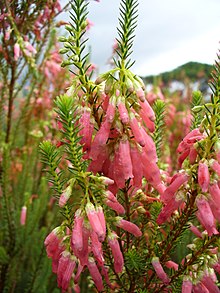Erica mammosa: Difference between revisions
Darorcilmir (talk | contribs) No edit summary |
m Task 3: +{{Taxonbar|from=Q5387946}} (4 sig. taxon IDs); WP:GenFixes using AWB |
||
| Line 19: | Line 19: | ||
It is a shrub, growing to {{convert| 2.5|m|ft|abbr=on}} tall and broad, that produces masses of flowers in a range of colours from light-pink to orange to bright red. |
It is a shrub, growing to {{convert| 2.5|m|ft|abbr=on}} tall and broad, that produces masses of flowers in a range of colours from light-pink to orange to bright red. |
||
The species name ''"mammosa"'' means "with breasts" and refers to the udder-like tubular shape of the flowers.<ref name=RHSLG>{{cite book |last=Harrison |first=Lorraine |title=RHS Latin for Gardeners |year=2012 |publisher=Mitchell Beazley |location=United Kingdom |isbn=184533731X }}</ref> |
The species name ''"mammosa"'' means "with breasts" and refers to the udder-like tubular shape of the flowers.<ref name=RHSLG>{{cite book |last=Harrison |first=Lorraine |title=RHS Latin for Gardeners |year=2012 |publisher=Mitchell Beazley |location=United Kingdom |isbn=184533731X }}</ref> |
||
This plant is increasingly popular as an ornamental garden subject.<ref>http://www.plantzafrica.com/plantefg/ericamammosa.htm</ref> |
This plant is increasingly popular as an ornamental garden subject.<ref>http://www.plantzafrica.com/plantefg/ericamammosa.htm</ref> |
||
| Line 25: | Line 25: | ||
| title = RHS Plantfinder - ''Erica mammosa'' |
| title = RHS Plantfinder - ''Erica mammosa'' |
||
| accessdate=17 February 2018}}</ref><ref>{{cite web | url= https://www.rhs.org.uk/plants/pdfs/agm-lists/agm-ornamentals.pdf | title = AGM Plants - Ornamental | date = July 2017 | page = 36 | publisher = Royal Horticultural Society |
| accessdate=17 February 2018}}</ref><ref>{{cite web | url= https://www.rhs.org.uk/plants/pdfs/agm-lists/agm-ornamentals.pdf | title = AGM Plants - Ornamental | date = July 2017 | page = 36 | publisher = Royal Horticultural Society |
||
| accessdate = 16 February 2018}}</ref> Like many heathers it is a [[calcifuge]], meaning that it must be grown in an acidic soil. It requires a sunny, sheltered spot with sharp drainage. It tolerates low temperatures down to {{convert| 0|C|F|abbr=on}}, but will not stand freezing.<ref name = RHSPF |
| accessdate = 16 February 2018}}</ref> Like many heathers it is a [[calcifuge]], meaning that it must be grown in an acidic soil. It requires a sunny, sheltered spot with sharp drainage. It tolerates low temperatures down to {{convert| 0|C|F|abbr=on}}, but will not stand freezing.<ref name = RHSPF /> |
||
==Gallery== |
==Gallery== |
||
| Line 42: | Line 42: | ||
{{Reflist}} |
{{Reflist}} |
||
{{Taxonbar|from=Q5387946}} |
|||
[[Category:Erica|mammosa]] |
[[Category:Erica|mammosa]] |
||
Revision as of 22:37, 21 March 2018
| Erica mammosa | |
|---|---|

| |
| Scientific classification | |
| Kingdom: | |
| (unranked): | |
| (unranked): | |
| (unranked): | |
| Order: | |
| Family: | |
| Genus: | |
| Species: | E. mammosa
|
| Binomial name | |
| Erica mammosa | |
Erica mammosa (the nine-pin heath) is a species of flowering plant in the family Ericaceae, that was naturally restricted to the south-western corner of the Western Cape, South Africa.
It is a shrub, growing to 2.5 m (8.2 ft) tall and broad, that produces masses of flowers in a range of colours from light-pink to orange to bright red.
The species name "mammosa" means "with breasts" and refers to the udder-like tubular shape of the flowers.[2]
This plant is increasingly popular as an ornamental garden subject.[3] In the UK it has gained the Royal Horticultural Society’s Award of Garden Merit.[4][5] Like many heathers it is a calcifuge, meaning that it must be grown in an acidic soil. It requires a sunny, sheltered spot with sharp drainage. It tolerates low temperatures down to 0 °C (32 °F), but will not stand freezing.[4]
Gallery
See also
References
- ^ "Erica mammosa". The Plant List. Retrieved 17 February 2018.
- ^ Harrison, Lorraine (2012). RHS Latin for Gardeners. United Kingdom: Mitchell Beazley. ISBN 184533731X.
- ^ http://www.plantzafrica.com/plantefg/ericamammosa.htm
- ^ a b "RHS Plantfinder - Erica mammosa". Retrieved 17 February 2018.
- ^ "AGM Plants - Ornamental" (PDF). Royal Horticultural Society. July 2017. p. 36. Retrieved 16 February 2018.


